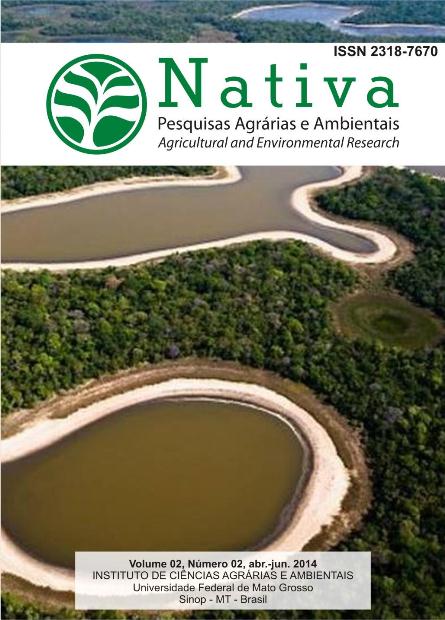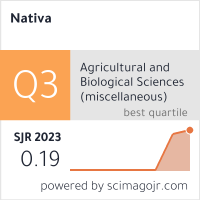MODELAGEM DA IRRADIAÇÃO SOLAR GLOBAL MÉDIA HORÁRIA MENSAL (Hgh) PARA QUATRO LOCALIDADES DE ALAGOAS/BRASIL
DOI:
https://doi.org/10.31413/nativa.v2i2.1412Resumo
Sete modelos empíricos (M1 a M7) baseados na temperatura do ar, foram ajustados e avaliados para estimar a irradiação solar global média horária mensal (Hgh) em quatro localidades do Estado de Alagoas, Brasil. Os dados foram medidos em estações solarimetricas automáticas situadas em Arapiraca (9°47’54,8”S e 37°36’23,4”W), Palmeira dos Índios (9°24’19,9”S e 36°39’22,7”W), Maceió (10°01’29,1”S e 36°16’29,1”W) e Coruripe (9°28’29,1”S e 35°49’43,6”W), entre 2007 e 2009. Para indicar o desempenho dos modelos utilizaram-se os indicativos estatísticos: desvio das médias (MBE), raiz quadrada do desvio quadrático médio (RMSE), “d” de Willmott e teste-t. Os coeficientes ajustados (β1 e β2) dos modelos foram dependentes da região e dos efeitos climáticos locais. Os coeficientes β2 dos M1, M2 e M3 foram significativos a 5%, enquanto que, o coeficiente β1 de M4 e M5 resultaram em comportamentos semelhantes. Os coeficientes β1 e β2 de M6 e M7 apresentaram elevadas oscilações. Com RMSE médio de 0,29 ± 0,15 MJ m-2h-1, o melhor ajuste para região de Arapiraca foi com M7. O melhor ajuste para as condições climáticas nas regiões de Palmeira dos Índios, Maceió e Coruripe foi com M4. Estes resultados mostram a eficiência dos modelos empíricos em prever Hgh.
Palavras-chave: Modelos empíricos, Bristow e Campbell, Hargreaves e Samani, condições climáticas.
MODELLING OF MONTHLY HOURLY GLOBAL SOLAR IRRADIATION (Hgh) TO FOUR SITES IN ALAGOAS/BRAZIL
ABSTRACT
In this paper was used seven empirical models (M1 to M7) based on temperature of air and they were fitted and validated to estimating the monthly hourly of global solar irradiation (Hgh) in four sites in Alagoas State, Brazil. The data were measured in automatic solarimetric stations situated in Arapiraca (9°47’54.8”S and 37°36’23.4”W), Palmeira dos Índios (9°24’19.9”S and 36°39’22.7”W), Maceió (10°01’29.1”S and 36°16’29.1”W) and Coruripe (9°28’29.1”S and 35°49’43.6”W), from 2007 to 2009. To indicate the models performance were used: Mean Bias Error (MBE), Root Mean Square Error (RMSE), “d” of Willmott and t-test. The fitted coefficients (β1 and β2) of models were dependents of region and local climatic effects. The coefficients β2 of M1, M2 and M3 were significantly different at the level of 5%. The β1 coefficient of M4 and M5 resulted in similar oscillations. The β1 and β2 coefficients of M6 and M7 presented high oscillations. With RMSE average of 0.29±0.15 MJ m-2 h-1, the best fitted model for the Arapiraca region was M7. The best fitted model for the climatic conditions in the region of Palmeira dos Índios, Maceió and Coruripe were M4. The M4 generated the best result among the evaluated models. These results showed the efficiency of the empirical models to predict Hgh.
Keywords: Empirical models, Bristow and Campbell, Hargreaves and Samani, Climatic conditions.
Referências
ABRAHA, M. G.; SAVAGE, M. J. Comparison of estimates of daily solar radiation from air temperature range for application in crop simulations. Agricultural and Forest Meteorology, v.148, n.3, p.401-416, mar. 2008.
ALADOS, I. et al. Estimation of photosynthetically active radiation under cloudy conditions. Agricultural and Forest Meteorology, v.102, n.1, p.39-50, abr. 2000.
ALLEN, R. et al. Crop evapotranspiration-Guidelines for computing crop water. Rome: FAO, 1998 300p. (Irragation and drainage paper, n.56, 1998)
ALLEN, R. Evaluation of procedures of estimating mean solar radiation from air temperature. Rome: FAO, 1995. 120p.
ALLEN, R. G. Assessing integrity of weather data for reference evapotranspiration estimation. Journal of Irrigation and Drainage Engineering, v. 122, n. 2, p.97-106, mar. 1996.
ALMOROX, J. et al. Estimation of daily global solar radiation from measured temperature ate Cañada de Luque, Córdoba, Argentina. Renewable Energy, v.60, p.382-387, dez. 2013.
ALMOROX, J. et al. Models for obtaining daily global solar radiation with measured air temperature data in Madrid (Spain). Applied Energy, v.88, n.5, p. 1703-1709, maio 2011.
ÁLVAREZ, J. et al. Estimating monthly solar radiation in south central Chile. Chilean Journal of Agricultural Research, Chillan, v.71, n.2, p.601-6-9, oct./dec. 2011.
ANNANDALE, J. G. et al. Software for missing data error analysis of Penman–Monteith reference evapotranspiration. Irrigation Science, v.21, n.2, p.57-67, mar. 2002.
BALL, R. et al. Evaluation of solar radiation prediction models in North America. Agronomy Journal, Madison, v.96, n.5, p. 391-397, set. 2004.
BOLAND, J. et al. Models of diffuse solar radiation. Renewable Energy, v.33, n.4, p.575-584, abr. 2008.
BORGES, V. P. et al. M. Avaliação de modelos de estimativa da radiação solar incidente em Cruz das Almas, Bahia. Revista Brasileira de Engenharia Agrícola e Ambiental, Campina Grande, v.14, n.1, p.74-80, jan. 2010.
BRISTOW, K. L.; CAMPBELL, G. S. On the relationship between incoming solar radiation and daily maximum and minimum temperature. Agricultural and Forest Meteorology, v.31, n.2, p.159-166, maio 1984.
CHEN, R. et al. Validation of five models with measured daily data in China. Energy Conversion and Management, v.45, n.11-12, p.1759-1769, jul. 2004.
ERTEKIN, C.; YALDIZ, O. Estimation of monthly average daily global radiation on horizontal surface for Antalya (Turkey). Renewable Energy, v.17, n.1, p.95-102, maio 1999.
ESCOBEDO, J. F. et al. An assessment of the diffuse radiation models for prediction on hourly global radiation in tilted surface. Nativa, Sinop, v.2, n.1, p.23-31, jan./mar. 2014.
EVRENDILEK, F.; ERTEKIN, C. Assessing solar radiation models using multiple variables over Turkey. Climate Dynamics, v.31, n.2-3, p.31-149, ago. 2008.
HARGREAVES, G. L. et al. Irrigation water requirement for Senegal River Basin. Journal of Irrigation and Drainage Engineering, v.111, n.3, p.265-275, set.1985.
HARGREAVES, G. L; SAMANI, Z. A. Estimating potential evapotranspiration. Journal of Irrigation and Drainage Engineering, v.108, n.3, p.225-230, set. 1982.
HUNT, L. A. et al. Estimation of solar radiation for use in crop modeling. Agricultural and Forest Meteorology, v.91, n.3-4, p.293-300, jun. 1998.
INSTITUTO NACIONAL DE PESQUISAS ESPACIAIS (INPE). Climanálise. Boletim de Monitoramento e Análise Climática, Cachoeira Paulista, v.24, n.2, p.1-47, fev. 2009.
KOUSSA, M. et al. Statistical comparison of monthly mean hourly and daily diffuse and global solar irradiation models and a Simulink program development for various Algerian climates. Energy Conversion and Management, v.50, n.5, p.1227-1235, maio 2009.
LIU, X. et al. Evaluation of temperature-based global solar radiation models in China. Agricultural and Forest Meteorology, v.149, n.9, p.1433-1446, set. 2009.
LIZASO, J. L. et al. Development of a leaf – level canopy assimilation model for CERES – Maize. Agronomy Journal, Madison, v.97, n.3, p.722-733, maio 2005.
MAGHRABI, A. H. Parameterization of a simple model to estimate monthly global solar radiation based on meteorological variables, and evaluation of existing solar radiation models for Tabouk, Saudi Arabia. Energy Conversion and Management, v.50, n.11, p. 2754-2760, nov. 2009.
MELO, S. B. Modelagem da irradiação solar global para a região de Mossoró – RN. 2009. 106f. Dissertação (Mestrado em Meteorologia Agrícola) – Universidade Federal de Viçosa, 2009.
MEZA, F.; VARAS, E. Estimation of mean monthly solar global radiation as a function of temperature. Agricultural and Forest Meteorology, v.1 00, n.2-3, p.231-241, fev. 2000.
PANDEY, P. K.; SOUPIR, M. L. A new method to estimate average hourly global solar radiation on the horizontal surface. Atmospheric Research, v. 114-115, n.1, p.83-90, out. 2012.
REIKARD, G. Predicting solar radiation at high resolutions: A comparison of time series Forecasts. Solar Energy, v.83, n.5, p.342-349, mar. 2009.
SAMANI, Z. Estimating solar radiation and evapotranspiration using minimum climatological data. Journal of Irrigation and Drainage Engineering, v.126, n.4, p.265-267, jul. 2000.
SILVA, C. R. et al. Radiação solar estimada com base na temperatura do ar para três regiões de Minas Gerais. Revista Brasileira de Engenharia Agrícola e Ambiental, Campina Grande, v.16, n.3, p.281-288, mar. 2012.
SOUZA, J. L. et al. Global solar radiation measurements in Maceió, Brazil. Renewable Energy, v.30, n.8, p.1203-1220, jul. 2005.
SPOKAS, K.; FORCELA, F. Estimating hourly incoming solar radiation from limited meteorological data. Weed Science, Washington D.C., v.54, n.1, p.182-189, jan. 2006.
THORNTHWAITE, C. W., MATHER, J. R. The water balance. Centerton: Drexel Institute of Technology, 1995. 104p. (Publications in Climatology, v.8, n.1, 1955).
WEISS, A. et al. Incorporating bias error in calculating solar irradiance: implications for crop yield simulations. Agronomy Journal, Madison, v.93, n.6, p.1321–1326, nov./dez. 2001.
WILLMOTT, C. J. Some comments on the evaluation of model performance. Bulletin American Meteorological Society, Boston, v.63, n.11, p.1309-1313, nov. 1982.
Downloads
Publicado
Edição
Seção
Como Citar
Licença
Direitos Autorais para artigos publicados nesta revista são do autor, com direitos de primeira publicação para a revista. Em virtude de a aparecerem nesta revista de acesso público, os artigos são de uso gratuito, com atribuições próprias, em aplicações educacionais e não-comerciais.
A artigos publicados nessa revista, podem ser reproduzidos parcialmente ou utilizados como referência por outros autores, desde que seja cita a fonte, ou seja, a Revista Nativa.
Copyright for articles published in this journal are the authors, with first publication rights granted to the journal. The journal shows open access, and articles are free to use, with proper attribution, in educational and non-commercial.
The articles published in this journal may be reproduced in part or used as a reference by other authors, provided that the source is quoted.






